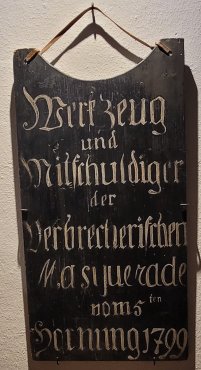1799 Kürassier and the French - Chur masquerade
Since the Reformation, dancing, string playing, "Butzen und Maskeraden gehen" were forbidden in Chur. Nevertheless, the people of Chur did not let themselves be stopped from celebrating the carnival with games, dancing and masquerades. And some Churians made fun of the French as soldiers in disguise.
Due to the political events of that time, the masquerade of 1799 attracted attention far beyond the borders of Chur and aroused displeasure and indignation in large parts of the Swiss Confederation. In the Helvetische Zeitung of February 9, 1799, the following can be read about it:
"In order to get an idea of the delicacy of the government there, and especially of the police in Chur, we give a description of a masquerade that was held in Chur the other day. First, a cuirassier, blowing the post horn, slowly rode in front of a wagon to gather the people; then the wagon followed, on which 4 masks were seated, to which was attached at the back a freedom tree with a freedom hat. They dragged him through the streets of the city, which had become very unclean due to the thaw. Next to him walked wistfully two persons, who were supposed to represent crosswise Frenchmen. Another wild mask that followed behind them beat them from time to time. One of the masks representing the captured Franks wore the Freyheitsmütze, the other the Swiss hat, but both wore the French uniform and cocard. This was followed by a cuirassier, who swung his bare rapier over the Frenchman in order to keep the curious rabble away from the wagon. The procession proceeded slowly to the outskirts of the French village. At each patriot house HALT was made and in retreat the Freyheits-Baum was thrown down into the Plessur over the Bruk."[21]
The participants of this masquerade were arrested, interrogated and sentenced. A pillory board was then specially created, intended for public carrying around by the two Churians. On it was to be read: "Tool and accomplice of the criminal masquerade of the 5th hornung 1799". The two main actors, glazier Christian Köhl and fashion tailor Christian Scherich, who came from Heilbronn, were also expelled from the country. Among the condemned was also Bernhard Köhl, who, however, got off with a minor punishment.
Source:
21: Churer Stadtgeschichte, Ursula Jecklin, 1993
- The Sémonville Affair of 1793
- 1799 Chur masquerade
- House zu den drei Spielleuten
Impressum und rechtliche Hinweise
